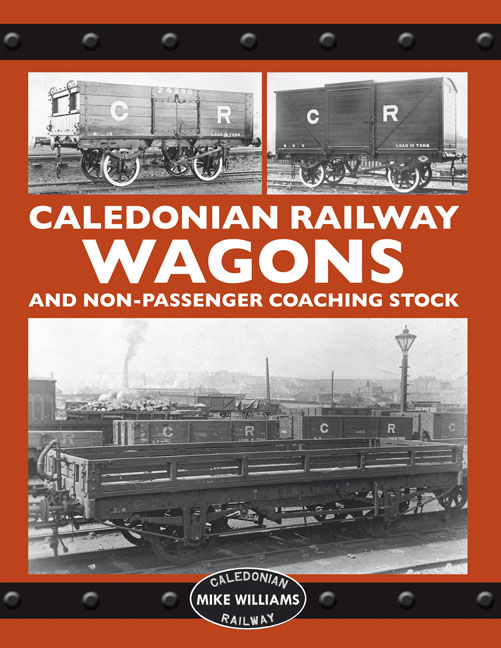Caledonian Railway Wagons and Non-Passenger Coaching Stock

Mike Williams
320 pages. 275x215mm. Printed on gloss art paper, casebound with printed board covers.
ISBN13 : 9781899889747
£30.00
CONTENTS
Chapter 1: Introduction and Sources of Information
1.1: Introduction page 7
1.2: Sources of Information - The Caledonian Railway page 9
1.3: Sources of Information - Outside Contractors page 13
1.4: Sources of Information - The Technical and Enthusiast's Press page 15
Chapter 2: The Growth and Development of the Wagon Fleet
2.1: Commercial Influences and Infrastructure page 17
2.2: Types of Wagon and Numbers in Service page 29
2.3: Technical Development - Historical Overview page 33
2.4: Running Gear page 35
2.5: Brakes page 39
2.6: Buffers and Drawgear page 4
Chapter 3: Wagon Livery and Numbering
3.1: Livery page 47
3.2: Letter and Number Styles page 51
3.3: Location of Letters and Painted Numbers page 59
3.4: Cast Number and Builder's Plates page 67
3.5: Allocation of Numbers page 69
Chapter 4: Non-Passenger Coaching Stock Livery and Numbering
4.1: The NPCS Livery page 73
4.2: NPCS in Passenger Livery page 77
4.3: Lettering and Numerals page 79
4.4: Allocation of Numbers page 81
Chapter 5: General Mineral Wagons
5.1: Introduction page page 83
5.2: The Early 'Bogies' page 85
5.3: Four-Wheeled Wagon Development 1883-1899 page 89
5.4: Bogie Mineral Wagons page 93
5.5: Four-Wheeled Wagon Development Post 1900 page 99
Chapter 6: Specialised Mineral Wagons
6.1: Hopper Wagons page 107
6.2: Coke page 111
6.3: Pig Iron Wagons page 113
Chapter 7: Private Traders' Wagons
7.1: Wagons Owned by Private Traders page 117
7.2: Thirled Wagons page 121
7.3: Tank Wagons page 123
Chapter 8: Steel, Timber and Stone Wagons
8.1: Four and Six Wheeled Rail and Tube Wagons page 125
8.2: Timber and Swivel Wagons page 131
8.3: Twin Wagons page 137
8.4: Stone Wagons page 141
Chapter 9: Ordinary Goods Wagons And Vans
9.1: Open Goods page 143
9.2: Covered Goods page 151
9.3: Empty Barrel Trucks page 163
9.4: Road Vans page 165
Chapter 10: Perishable Goods
10.1: Meat Vans page 167
10.2: Fish, Fruit and Milk page 173
Chapter 11: Livestock Wagons
11.1: Cattle page 183
11.2: Sheep and Other Livestock page 191
11.3: Horses page 193
Chapter 12: Carriage and Scenery Trucks
12.1: Open Carriage Trucks page 199
12.2: Covered Carriage Trucks page 203
12.3: Scenery Trucks page 207
Chapter 13: Special Class Wagons - The Trollies
13.1: Introduction and Pre-Diagram Book Designs page 209
13.2: Trollies with 18/20-foot Wells page 211
13.3: Trollies with 25-foot Wells page 213
13.4: Trollies with 35/40-foot Wells page 215
Chapter 14: Other Special Class Bogie Wagons
14.1: Bogie Rail and Swivel Bar Wagons page 219
14.2: Glass and Well Wagons page 221
14.3: Flat Wagons page 223
14.4: Heavy Weight and Ingot Wagons page 225
14.5: Gun Sets and Warflats page 227
Chapter 15: Four- and Six-Wheeled Special Class Wagons
15.1: Glass Well Wagons page 229
15.2: Locomotive and Boiler Wagons page 231
15.3: Machinery and Agricultural Implement Wagons page 233
15.4: Flat Wagons and Runners page 237
15.5: Swivel Bar and Heavy Weight Wagons page 239
15.6: Gunpowder Vans page 241
Chapter 16: Goods and Mineral Brake Vans
16.1: Four-Wheeled Brake Vans and Wagons page 243
16.2: Six-Wheeled Brake Vans page 255
Chapter 17: Service Vehicles
17.1: Loco Coal and Ash page 257
17.2: Ballast Wagons page 265
17.3: Ballast Brakes page 269
17.4: Gas Tanks page 271
17.5: Tank Wagons page 273
17.6: Breakdown Cranes and Associated Vehicles page 275
17.7: Engineer's Department Vehicles page 281
